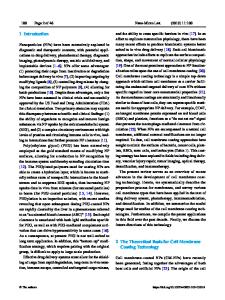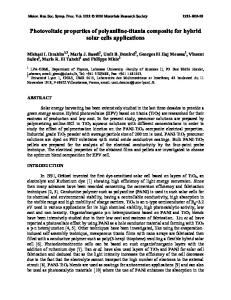Latex-Like Water-Borne Polyaniline for Coating Applications
- PDF / 391,881 Bytes
- 6 Pages / 414.72 x 648 pts Page_size
- 73 Downloads / 442 Views
the use of volatile organic solvent. In this article we report the synthesis of PAN:PVME-MLA as a latex-like water-borne coating material. PAN:PVME-MLA is a molecular complex of polyaniline and poly(vinylmethylether-co-maleic acid). This polymeric complex is dispersable in water as a stable suspension, and once the coating is dried on a substrate, it is not dissolvable by water. The coating is fixed without the need for radiative or chemical cross-link, and therefore is more generally applicable as a coating material. The molecular complex PAN:PVME-MLA has another advantage over the conventional polyaniline. The conventional polyaniline easily loses its molecular or ionic dopants to result in a loss of electrical conductivity. Heat and moisture cause the dopants to be either segregated from the conducting polymer or be washed out by water or solvents. This problem is avoided in polymeric complexes of polyaniline because the polymeric dopant is part of the stable molecular complex. The applications of this material as antielectrostatic and electroactive coatings are discussed in this article.
747 Mat. Res. Soc. Symp. Proc. Vol. 488 © 1998 Materials Research Society
SYNTHESIS OF PAN:PVME-MLA Strand #2: Poly(styrenesulfonic acid)
The soluble PAN:PVME-MLA is a molecular
complex of two strands of polymers: (1) a polyaniline molecule, and (2) poly(vinylmethylether-co-maleic acid). These two strands of polymers are bonded by noncovalent intermolecular attractive forces to form a stable molecular complex.' The polymeric complex PAN:PVME-MLA was synthesized by a template-guided synthetic method: In
M+ .•A
A
A
A
A
A"
A-
A
A
A
.
A
M+ A
A"
A
A
A
Ha
NHC N
N
N
H
H
H
Strand #1:
Polyanlllne radical cation
Double Strand Elactroactive
Polymer
Figure 1 A molecular complex of
polyaniline and a polyanion. the first step, the aniline monomers were adsorbed onto the poly(vinylmethylether-co-maleic acid) chains in aqueous solution. The resulting adduct, PVME-MLA:(Aniline)x, has signatures that can be monitored and verified. In the second step, the attached aniline monomers were oxidatively polymerized to form the polymeric complex.2 In order to produce latex-like dispersion of the polymeric complex, a new method of synthesis was used that has a subtle but important difference from the other template-guided syntheses reported previously",2 . In this new method, the polyanion serves not only as a template for forming the complex, but it also serves as an emulsifier that stabilizes the suspension of the reaction product. The resulting polymer is stably dispersed in water but is not a true solution. An example of the synthesis of a water-borne molecular complex PAN:PVME-MLA is described as the following: Dissolve 1.92 gm of poly(vinylmethylether-co-maleic acid), PVME-MLA, (containing 0.022 moles of carboxylic functional groups, Aldrich, M.W. = 67,000) in 25 ml of distilled water. Add 5 ml of methanol and slowly add 2 gram of aniline (0.022 mole of aniline) to this solution and stir for one hour. At this stag
Data Loading...











